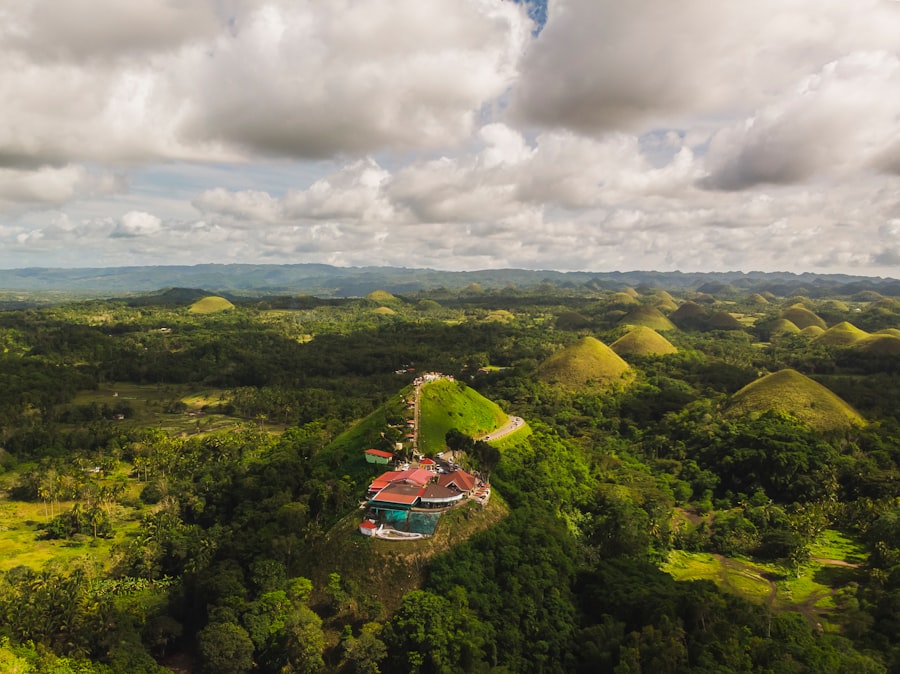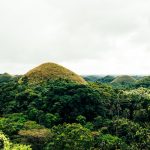Download links
How to install Discover the Enchanting Chocolate Hills APK?
1. Tap the downloaded Discover the Enchanting Chocolate Hills APK file.
2. Touch install.
3. Follow the steps on the screen.
Description
The Chocolate Hills, a geological marvel located in the heart of Bohol, Philippines, are a striking natural formation that captivates visitors with their unique appearance and intriguing origins. This extraordinary landscape consists of over 1,200 symmetrical hills, each rising to about 30 to 50 meters in height. The hills are covered in lush green grass that turns a rich brown during the dry season, resembling a vast expanse of chocolate mounds, hence the name.
The formation is not only visually stunning but also a testament to the complex geological processes that have shaped the region over millions of years.
The area was once submerged underwater, and as tectonic activity raised the seabed, the limestone formations were exposed to the elements.
Over time, rainwater and wind eroded the softer materials, leaving behind these conical hills. The unique topography is further enhanced by the region’s tropical climate, which contributes to the seasonal color changes of the hills. This geological wonder has earned its place as one of the Philippines’ most iconic landmarks and was declared a National Geological Monument in 1988.
Key Takeaways
- The Chocolate Hills in the Philippines are a geological wonder consisting of over 1,200 cone-shaped hills.
- The name “Chocolate Hills” comes from the brown color they turn during the dry season, resembling chocolate kisses.
- Visitors can explore the breathtaking views of the Chocolate Hills from viewing decks and hiking trails.
- The area is home to a diverse range of wildlife and plant species, including the endangered tarsier and various bird species.
- Travelers can easily access the Chocolate Hills from nearby towns and find accommodation in the surrounding area, supporting the local economy while preserving the beauty of the landscape.
The Legend Behind the Name
The Battle of the Giants
One popular legend tells the story of two giants who engaged in a fierce battle over a beautiful maiden. As they clashed, they hurled boulders at each other, creating the hills as they fought. After their battle ended, the giants left behind the mounds as a reminder of their conflict. Over time, grass grew over these formations, giving them their distinctive appearance.
A Giant’s Eternal Sorrow
Another legend speaks of a giant named Arogo, who fell deeply in love with a mortal woman named Aloya. When Aloya passed away, Arogo was heartbroken and wept for her loss. His tears formed the hills, symbolizing his eternal sorrow. This narrative adds a layer of emotional depth to the landscape, highlighting the significance of love and loss in local culture.
A Rich Tapestry of Stories
Such legends contribute to the allure of the Chocolate Hills, inviting visitors to engage with both the natural beauty and the rich tapestry of stories that define this remarkable site. The hills are more than just a natural wonder; they’re a window into the cultural heritage of the Boholano people and their deep connection to the land.
Exploring the Breathtaking Views

Visitors to the Chocolate Hills are often awestruck by the panoramic views that stretch across the horizon. The most popular viewpoint is located at the Chocolate Hills Complex in Carmen, where an observation deck provides an unobstructed vista of the rolling hills. From this vantage point, one can see the undulating landscape dotted with greenery, creating a mesmerizing patchwork that changes with the seasons.
The experience is particularly enchanting during sunrise or sunset when the hills are bathed in golden light, casting long shadows and enhancing their chocolate-like appearance. For those seeking a more immersive experience, hiking trails wind through the hills, allowing visitors to explore the terrain up close. The trails vary in difficulty, catering to both casual walkers and more adventurous trekkers.
As one navigates through the hills, they can appreciate the intricate details of the landscape—small wildflowers peeking through the grass, unique rock formations, and occasional glimpses of local wildlife. Each step reveals new perspectives and hidden gems within this geological wonder, making it an unforgettable adventure for nature enthusiasts and photographers alike.
Wildlife and Biodiversity in the Chocolate Hills
| Aspect | Metrics |
|---|---|
| Number of Species | Over 1,200 plant species and 11 mammal species |
| Endemic Species | Several species of birds, reptiles, and mammals are endemic to the Chocolate Hills |
| Conservation Status | Some species are listed as vulnerable or endangered |
| Habitat Diversity | Varied habitats including forests, grasslands, and wetlands |
The Chocolate Hills are not just a feast for the eyes; they also serve as a habitat for diverse flora and fauna. The region is home to various species of plants and animals that thrive in its unique ecosystem. The hills are primarily covered with grasslands, but patches of forest can be found in certain areas, providing shelter for numerous bird species and small mammals.
Among these are endemic birds like the Philippine tarsier, one of the smallest primates in the world, known for its large eyes and nocturnal habits. In addition to tarsiers, other wildlife such as monitor lizards and various species of butterflies can be spotted throughout the area. The biodiversity of the Chocolate Hills is crucial for maintaining ecological balance and supporting local conservation efforts.
The presence of these species highlights the importance of preserving their natural habitat amidst increasing tourism pressures. Efforts are underway to educate visitors about responsible wildlife observation and conservation practices to ensure that this unique ecosystem remains intact for future generations.
How to Get There and Where to Stay
Reaching the Chocolate Hills is relatively straightforward, making it accessible for both local and international travelers. The most common route begins in Tagbilaran City, Bohol’s capital, which is well-connected by air and sea transport. From Tagbilaran, visitors can hire a tricycle or rent a motorbike for a scenic drive to Carmen, where the Chocolate Hills are located.
The journey takes approximately 30 to 45 minutes and offers glimpses of rural life in Bohol, with rice fields and traditional houses dotting the landscape. Accommodations near the Chocolate Hills range from budget-friendly guesthouses to more upscale resorts. Many visitors choose to stay in Carmen itself for convenience, while others prefer to base themselves in Tagbilaran City or nearby Loboc for a broader range of amenities and attractions.
Staying in Loboc allows travelers to experience additional activities such as river cruises and visits to local waterfalls. Regardless of where one chooses to stay, proximity to the Chocolate Hills ensures easy access to this breathtaking natural wonder.
Preserving the Beauty of the Chocolate Hills

As tourism continues to grow in popularity at the Chocolate Hills, so does the need for sustainable practices to preserve this natural treasure. Local authorities have implemented measures aimed at protecting both the environment and cultural heritage associated with this site. These initiatives include establishing designated viewing areas to minimize human impact on sensitive ecosystems and promoting eco-friendly tourism practices among visitors.
Community involvement plays a crucial role in conservation efforts as well.
By fostering a sense of ownership among locals, these initiatives help ensure that future generations can enjoy the beauty of the Chocolate Hills while maintaining their ecological integrity.
Through collaboration between government agencies, local communities, and tourists, there is hope for preserving this geological wonder for years to come.
If you’re a fan of capturing beautiful landscapes like the Chocolate Hills, you may also enjoy reading about the Candy Camera app for editing photos. This article discusses how the app varies depending on the device you use, offering different features and options for enhancing your pictures. Check it out here for more information on how to make your photos even more stunning.
FAQs
What are the Chocolate Hills?
The Chocolate Hills are a geological formation in the Bohol province of the Philippines. They are made up of around 1,268 cone-shaped hills, which are covered in green grass that turns brown during the dry season, giving them the appearance of chocolate kisses.
How were the Chocolate Hills formed?
The exact formation process of the Chocolate Hills is still a subject of debate among geologists. However, it is widely believed that they are the result of the uplift of coral deposits and the action of rainwater and erosion over millions of years.
What is the best time to visit the Chocolate Hills?
The best time to visit the Chocolate Hills is during the dry season, which typically runs from late November to May. This is when the grass covering the hills turns brown, giving them their chocolate-like appearance.
Are there any activities to do at the Chocolate Hills?
Visitors to the Chocolate Hills can enjoy activities such as hiking, bird watching, and taking in the panoramic views from the viewing deck. There are also ATV tours and zip-lining options available for those seeking a more adventurous experience.
Is there an entrance fee to visit the Chocolate Hills?
Yes, there is an entrance fee to visit the Chocolate Hills. The fee helps with the maintenance and preservation of the area.





